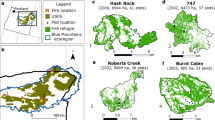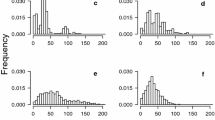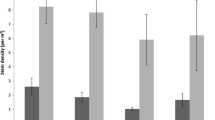Abstract
Human-induced wildfires are increasing in frequency in tropical forests, and their deleterious consequences for biodiversity include decreases in seed rain, which may be affected directly by fire or indirectly by the creation of edges between forest and non-forest environments. Understanding seed rain is key to assess the potential for natural regeneration in plant communities. We assessed the impact of fire and fire-created edges on seed rain species richness, abundance, size, weight, and dispersal syndromes in Atlantic Forest remnants in Bahia, Brazil. We assessed seed rain at monthly intervals for an entire year along seven 300 m-long transects placed perpendicular to the edge. We installed seed traps at the edge and at 20, 40, 60, 80, 100, and 150 m into the burnt area and into the forest from forest edge. We recorded a total of 9050 seeds belonging to 250 morphospecies. We did not observe edge influence; however, we detected a lower abundance and proportion of animal-dispersed seeds in the burnt than in the unburnt areas. The seed abundance in the burnt areas was lower and seeds were smaller and lighter than those in the unburnt area. Seed rain in the burnt area was not greater near to the forest than far from it. The abundance and richness of seed rain was positively correlated with tree density. Our findings highlight the lack of seed rain in burnt areas and differences in community composition between the burnt and unburnt areas. Collectively, these results indicate negative consequences on natural regeneration, which can lead to permanent secondarization of the vegetation and challenges for early regeneration of burnt areas, which will initially have impoverished forests due to low seed richness.






Similar content being viewed by others
Data availability
Code availability
Not applicable.
References
Armenteras D, González TM, Retana J (2013) Forest fragmentation and edge influence on fire occurrence and intensity under different management types in Amazon forests. Biol Conserv 159:73–79. https://doi.org/10.1016/j.biocon.2012.10.026
Arroyo-Rodríguez V, Melo FPL, Martínez-Ramos M, Bongers F, Chazdon RL, Meave JA et al (2017) Multiple successional pathways in human-modified tropical landscapes: new insights from forest succession, forest fragmentation and landscape ecology research. Biol Rev 92(1):326–340
Augsperger C, Franson S (1987) Wind dispersal of artificial fruits varying in mass, area and morphology. Ecology 68:27–42
Baker SC, Spies TA, Wardlaw TJ, Balmer J, Franklin JF, Jordan GJ (2013) The harvested side of edges: effect of retained forests on the re-establishment of biodiversity in adjacent harvested areas. For Ecol Manage 302:107–121
Balch JK, Nepstad DC, Brando PM, Curran L, Portela O, De Carvalho O, Febvre P (2008) Negative fire feedback in a transitional forest of southeastern Amazonia. Glob Change Biol 14:2276–2287. https://doi.org/10.1111/j.1365-2486.2008.01655.x
Barlow J, Peres CA (2004) Avifaunal responses to single and recurrent wildfires in Amazonian forests. Ecol Appl 14:1358–1373
Barlow J, Berenguer E, Carmenta R, França F (2020) Clarifying Amazonia’s burning crisis. Glob Change Biol 26:319–321
Bates D, Maechler M, Bolker B, Walker S (2015) Fitting linear mixed-effects models using lme4. J Stat Softw 67:1–48. https://doi.org/10.18637/jss.v067.i01
Berenguer E, Gardner TA, Ferreira J, Aragão LEOC, Mac Nally R, Thomson JR et al (2018) Seeing the woods through the saplings: using wood density to assess the recovery of humanmodified Amazonian forests. J Ecol 106(6):2190–2203
Bolker B, R Development Core Team (2017) bbmle: tools for general maximum likelihood estimation. R package version 1.0.20
Bond WJ, Keeley JE (2005) Fire as a global ‘herbivore’: the ecology and evolution of flammable ecosystems. Trends Ecol Evol 20(7):387–394. https://doi.org/10.1016/j.tree.2005.04.025
Burnham KP, Anderson DR (2004) Multimodel inference: understanding AIC and BIC in model selection. Sociol Methods Res. https://doi.org/10.1177/0049124104268644
Burrows CJ (1994) Seed trapping in Ahuriri Summit Bush Scenic Reserve, Port Hills, western Banks Peninsula, 1985–86. NZ J Bot 32:183–215. https://doi.org/10.1080/0028825X.1994.10410367
Capellesso ES, Scrovonski KL, Zanin EM, Sausen TL (2018) Relação entre chuva de sementes e estrutura florestal em remanescentes de Floresta Atlântica no Sul do Brasil. Iheringia 73:1–181
Casenavea JL, Pelotto JP, Protomastro J (1995) Edge-interior differences in vegetation structure and composition in a Chaco semi-arid forest, Argentina. For Ecol Manage 72:6l–69
Chabrerie O, Jamoneau A, Gallet-Moron E, Decocq G (2013) Maturation of forest edges is constrained by neighbouring agricultural land management. J Veg Sci 24:58–69
Chisholm RA, Wijedasa LS, Swinfield T (2016) The need for long-term remedies for Indonesia’s forest fires. Conserv Biol 30:5–6. https://doi.org/10.1111/cobi.12662;pmid:26612785
Cochrane M, Schulze MD (1999) Fire as a recurrent event in tropical forests of the Eastern Amazon: effects on forest structure, biomass, and species composition. Biotropica 31(1):2–166
Cochrane M, Skole DL, Matricardi EAT, Barber C, Chomentowski WH (2004) Selective logging, forest fragmentation, and fire disturbance. In: Zarin DJ, Alavalapati JRR, Putz FE, Schmink M (eds) Working forests in the neotropics: conservation through sustainable management? Columbia University Press, New York, pp 310–324
Cury RTdS, Montibeller-Santos C, Balch JK, Brando P, Mand Torezan JMD (2020) Effects of fire frequency on seed sources and regeneration in southeastern Amazonia. Front for Glob Change. https://doi.org/10.3389/ffgc.2020.00082
Denslow JS (1987) Tropical rain forest gaps and tree species diversity. Ann Rev Ecol Syst 18:432–452. https://doi.org/10.1146/annurev.es.18.110187.002243
Dodonov P, Harper KA, Silva-Matos DM (2013) The role of edge contrast and forest structure in edge influence: vegetation and microclimate in the Brazilian cerrado. Plant Ecol 214:1345–1359
Dodonov P, Zanelli CB, Silva-Matos DM (2018) Effects of an accidental dry-season fire on the reproductive phenology of two neotropical savanna shrubs. Braz J Biol 78:564–573
Drake DR (1998) Relationships among the seed rain seed bank and vegetation of a Hawaiian forest. J Veg Sci 9:103–112
Driscoll DA, Armenteras D, Bennett AF, Brotons L, Clarke MF, Doherty TS, Haslem A, Kelly LT, Sato CF, Sitters H, Aquilué N, Bell K, Chadid M, Duane A, Meza-Elizalde MC, Giljohann KM, González TM, Jambhekar R, Lazzari J, Morán-Ordóñez A, Wevill T (2021) How fire interacts with habitat loss and fragmentation. Biol Rev 96:976–998
Ehrlen J, Lehtila K (2002) How perennial are perennial plants? Oikos 98:308–322
Freitas CG, Dambros C, Camargo JLC (2013) Changes in seed rain across Atlantic forest fragments in Northeast Brazil. Acta Oecologica 53:49–55
Galetti M, Dirzo R (2013) Ecological and evolutionary consequences of living in a defaunated world. Biol Conserv 163:1–6
Granzow-de-la-Cerda Í, Lloret F, Ruiz JE, Vandermeer JH (2012) Tree mortality following ENSO-associated fires and drought in lowland rain forests of Eastern Nicaragua. For Ecol Manage 265:248–257
Griz LMS, Machado ICS (1998) Aspectos morfológicos e síndromes de dispersão de frutos e sementes na Reserva Ecológica de Dois Irmãos. In: Machado IC, Lopes AV, Pôrto KC (eds) Reserva Ecológica de Dois Irmãos: Estudos em um Remanescente de Mata Atlântica em área urbana. Editora Universitária da Universidade Federal de Pernambuco, Recife, pp 197–224
Guariguata MR, Pinard MA (1998) Ecological knowledge of regeneration from seed in neotropical forest trees: implications for natural forest management. For Ecol Manage 112:87–89
Harper KA, Lesieur D, Bergeron Y, Drapeau P (2004) Forest structure and composition at young fire and cut edges in black spruce boreal forest. Can J for Res 34:289–302
Harper KA, Macdonald SE, Burton PJ, Chen J, Brosofske KD, Saunders SC, Esseen PA (2005) Edge influence on forest structure and composition in fragmented landscapes. Conserv Biol 19:768–782
Hoffmann WA (1998) Post-burn reproduction of woody plants in a neotropical savanna: the relative importance of sexual and vegetative reproduction. J Appl Ecol 35:422–433
Hoffmann WA, Moreira AG (2002) The role of fire in population dynamics of woody plants. In: Oliveira PS, Marquis RJ (eds) The cerrados of Brazil: ecology and natural history of a neotropical savanna. Columbia University Press, New York, pp 159–177
Hoffmann WA, Orthen B, Nascimento PKV (2003) Comparative fire ecology of tropical savanna and forest trees. Funct Ecol 17:720–726
Holl KD (2002) Long-term vegetation recovery on reclaimed coal surface mines in the eastern USA. J Appl Ecol 39:960–970
Howe HF (2016) Making dispersal syndromes and networks useful in tropical conservation and restoration. Glob Ecol Conserv 6:152–178. https://doi.org/10.1016/j.gecco.2016.03.002
Ingle NR (2002) Seed dispersal by wind, birds, and bats between Philippine montane rainforest and successional vegetation. Oecologia 134:251–261
Jensen K (1998) Species composition of soil seed bank and seed rain of abandoned wet meadows and their relations to aboveground vegetation. Flora 193:345–359
Jordano J, Schupp EW (2000) Seed disperser effectiveness: the quantity component and patterns of seed rain for Prunus mahaleb. Ecol Monogr 70:591–615
Kelly LT et al (2020) Fire and biodiversity in the anthropocene. Science. https://doi.org/10.1126/science.abb0355
Laurance WF (2007) Have we overstated the tropical biodiversity crisis? Trends Ecol Evol 22:65–70
Laurance WF, Curran TJ (2008) Impacts of wind disturbance on fragmented tropical forests: a review and synthesis. Austral Ecol 33:399–408
Levey DJ (2005) Effects of landscape corridors on seed dispersal by birds. Science 309:146–148
Manly BFJ (2007) Randomization, bootstrap, and monte carlo methods in biology, 3rd edn. Chapman and Hall, Boca Raton
Martini AMZ, Santos FAM (2007) Effects of distinct types of disturbance on seed rain in the Atlantic forest of NE Brazil. Plant Ecol 190:81–95
Maurin O, Davies TJ, Burrows JE, Daru BH, Yessoufou K, Muasya AM, Bank M, Bond WJ (2014) Savanna fire and the origins of the “underground forests” of Africa. New Phytol 204:201–214
Melo FPL, Dirzo R, Tabarelli M (2006) Biased seed rain in forest edges: evidence from the Brazilian Atlantic forest. Biol Conserv 132:50–60
Menezes GSC, Cazetta E, Dodonov P (2019) Vegetation structure across fire edges in a neotropical rain forest. For Ecol Manage 453:17587
Moles AT, Ackerly DD, Webb CO, Tweddle JC, Dickie JB, Pitman AJ et al (2005) Factors that shape seed mass evolution. Proc Natl Acad Sci USA 102:10540–10544
Moran C, Catterall CP (2010) Can functional traits predict ecological interactions? A case study using rain forest frugivores and plants in Australia. Biotropica 42:318–326
Murcia C (1995) Edge effects in fragmented forests: implications for conservation. Trends Ecol Evol 10:58–62
Nathan R, Horn HS, Chave J, Levin SA (2002) Mechanistic models for tree seed dispersal by wind in dense forests and open landscapes. In: Levey DJ et al (eds) Seed dispersal and frugivory: ecology, evolution and conservation. CAB International, Princeton, pp 69–82
Oksanen J et al (2009) Vegan: community ecology package. R package version, v1. p 8
Parkins K, York A, Di Stefano J (2018) Edge effects in fire-prone landscapes: ecological importance and implications for fauna. Ecol Evol 8:5937–5948. https://doi.org/10.1002/ece3.4076
Pausas JG, Keeley JE, Verdú M (2006) Inferring differential evolutionary processes of plant persistence traits in Northern Hemisphere Mediterranean fire-prone ecosystems. J Ecol 94:31–39
Pinheiro J, Bates D, DebRoy S, Sarkar D, R Core Team (2017) nlme: linear and nonlinear mixed effects models. R package version 3.1–131
Piotto D, Craven D, Montagnini F, Ashton M, Oliver C, Thomas WW (2019) Successional, spatial, and seasonal changes in seed rain in the Atlantic forest of southern Bahia, Brazil. PLoS ONE 14:e0226474
Pollock SZ, Nielsen SE, St. Clair CC (2017) A railway increases the abundance and accelerates the phenology of bear-attracting plants in a forested, mountain park. Ecosphere 8:e01985
Potts JR, Hillen T, Lewis MA (2016) The “edge effect” phenomenon: deriving population abundance patterns from individual animal movement decisions. Theor Ecol 9:233–247. https://doi.org/10.1007/s12080-015-0283-7
R Core Team (2017) R: a language and environment for statistical computing. R Foundation for Statistical Computing, Vienna, Austria. https://www.R-project.org/. Accessed 12 Oct 2021
Rodrigues RR, Lima RAF, Gandolfi S, Nave AG (2009) On the restoration of high diversity forests: 30 years of experience in the Brazilian Atlantic forest. Biol Conserv 142:1242–1251
Rother DC, Pizo MA, Siqueira T, Rodrigues RR, Jordano P (2015) Community-wide spatial and temporal discordances of seed-seedling shadows in a tropical rainforest. PLoS ONE 10(4):e0123346. https://doi.org/10.1371/journal.pone.0123346
Russell-Smith J, Yates CP, Edwards A et al (2003) Contemporary fire regimes of northern Australia: change since Aboriginal occupancy, challenges for sustainable management. Int J Wildland Fire 12:283–297
Santos HG, Carvalho Junior W, Dart RO, Aglio MLD, Sousa JS, Pares JG, Fontana A, Martins ALS, Oliveira AP (2011) O novo mapa de solos do Brasil: legenda atualizada. Embrapa Solos 67:1517–2627
SEI (1998) Atributos Climáticos do Estado da Bahia. https://www.sei.ba.gov.br/. Accessed 03 June 2017
Silva USR, Silva-Matos DM (2006) The invasion of Pteridium aquilinum and the impoverishment of the seed bank in fire prone areas on Brazilian Atlantic forest. Biodivers Conserv 15:3035–3043
Ssali F, Moe SR, Sheil D (2018) Tree seed rain and seed removal, but not the seed bank, impede forest recovery in bracken (Pteridium aquilinum (L.) Kuhn)-dominated clearings in the African highlands. Ecol Evol 8:4224–4236
Tabarelli M, Silva JMC, Gascon C (2004) Forest fragmentation, synergisms and the impoverishment of neotropical forests. Biodivers Conserv 13:1419–1425
Tabarelli M, Venceslau Aguiar A, Ribeiro MC, Metzger JP, Peres CA (2010) Prospects for biodiversity conservation in the Atlantic forest: lessons from aging human-modified landscapes. Biol Conserv 143:2328–2340
Thonicke K, Venevsky S, Sitch S, Cramer W (2001) The role of fire disturbance for global vegetation dynamics: coupling fire into a dynamic global vegetation model. Glob Ecol Biogeogr 10:661–677
Todeschini F, Toledo JJL, Rosalino M, Hilário RR (2020) Niche differentiation mechanisms among canopy frugivores and zoochoric trees in the northeastern extreme of the Amazon. Acta Amazon 50:263–272
Traveset A, Rodríguez-Pérez J (2008) Seed dispersal. Encycl Ecol. https://doi.org/10.1016/b978-008045405-4.00860-0
Van der Pijl L (1972) Principles of dispersal in higher plants. Springer, Berlin
Vespa NI, Zurita GA, Bellocq MI (2014) Functional responses to edge effects: Seed dispersal in the southern Atlantic forest, Argentina. For Ecol Manage 328:310–318
Vespa NI, Zurita GA, Gatti MG, Bellocq MI (2018) Seed movement between the native forest and monoculture tree plantations in the southern Atlantic forest: a functional approach. For Ecol Manage 430:126–133
Whitmore TC (1983) Secondary succession from seed in tropical rain forests. For Abstr 44:767–779
Wood SN (2011) Fast stable restricted maximum likelihood and marginal likelihood estimation of semiparametric generalized linear models. J R Stat Soc 73:3–36
Wood S, Sheipl F (2020) gamm4: generalized additive mixed models using ‘mgcv’ and ‘lme4’. R package version 0.2–6
Zuur AF, Ieno EN, Walker NJ, Saveliev AA, Smith GM (2009) Mixed effects models and extensions in ecology with R. Statistics for Biology and Health, New York
Acknowledgements
We are grateful to ICMBio (Chico Mendes Institute for Biodiversity Conservation) for the authorization to carry out the research in the RVS de Una (SISBIO License No. 60990-1), to Adson Santos for his assistance in data collection and to Rafael de Oliveira Xavier and Juliana Silveira dos Santos, and three anonymous reviewers, whose suggestions improved the manuscript, and Caroline Franklin for English reviewing.
Funding
This study was funded by the Rectorate for Research and Post-Graduation of the State University of Santa Cruz—UESC (PROPP—Project Number 00220.1100.1773). We received financial support from Idea Wild for essential field equipment. JISR received a Masters scholarship from the Fundação de Amparo à Pesquisa do Estado da Bahia (FAPESB) and GSCM received a Masters scholarship from the Coordenação de Aperfeiçoamento de Pessoal de Nível Superior—Brasil (CAPES)—Finance Code 001, PD received a post-doctoral scholarship from the Coordenação de Aperfeiçoamento de Pessoal de Nível Superior—Brasil (CAPES)—PNPD. EC thanks the CNPq for the productivity fellowship (306373/2018–1).
Author information
Authors and Affiliations
Contributions
All authors contributed to the study conception. Material preparation, data collection, and analysis were performed by JIdSR, PD, and DCT. The first draft of the manuscript was written by JIdSR, and all authors contributed on all versions, reading and approving the manuscript.
Corresponding author
Ethics declarations
Conflict of interest
The authors declare that they have no conflict of interest.
Additional information
Communicated by Christopher Carcaillet.
Publisher's Note
Springer Nature remains neutral with regard to jurisdictional claims in published maps and institutional affiliations.
Rights and permissions
About this article
Cite this article
da Silva Rocha, J.I., Menezes, G.S.C., Cazetta, E. et al. Seed rain across fire-created edges in a neotropical rainforest. Plant Ecol 223, 247–261 (2022). https://doi.org/10.1007/s11258-021-01205-6
Received:
Accepted:
Published:
Issue Date:
DOI: https://doi.org/10.1007/s11258-021-01205-6




